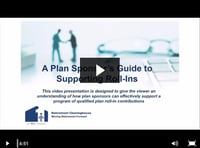 Why should plans care about roll-in contributions? Establishing a program that encourages participant rollover contributions (or “roll-ins”) is one of the most beneficial programs that a plan can implement.
Why should plans care about roll-in contributions? Establishing a program that encourages participant rollover contributions (or “roll-ins”) is one of the most beneficial programs that a plan can implement.

Thanks for reporting a problem. We'll attach technical data about this session to help us figure out the issue. Which of these best describes the problem?
Any other details or context?
Why should plans care about roll-in contributions?
Establishing a program that encourages participant rollover contributions (or “roll-ins”) is one of the most beneficial programs that a plan can implement.
For participants, roll-ins:
- Consolidate retirement savings
- Reduce fees from holding multiple retirement accounts
- Simplify retirement planning
- Are proven to decrease the incidence of cashouts
For plans, roll-ins:
- Increase average balances
- Enhance financial wellness metrics
- Reduce the number of small accounts
- Improve the effectiveness of in-plan retirement income solutions
What steps can a plan take to support roll-ins?
- Make sure that the plan accepts roll-ins. This should be clearly-identified in the plan document, in the section addressing plan contributions.
- Clearly communicate the plan’s roll-in feature to participants, particularly at initial eligibility and during annual enrollment.
Example forms of communication include:
- Printed materials
- Participant E-Mails
- Internal benefits website
Be sure to emphasize:
- Saving the participant time & money
- Un-complicating participants’ lives
- Improving the participant’s retirement readiness
- Offer essential roll-in support, including instructions and easy access to the required contribution forms
Will my plan’s recordkeeper do a good job of supporting roll-ins?
It depends.
- Roll-ins can be complex transactions, with many variations. Most recordkeepers are more-familiar with high-volume, repetitive transactions.
- The nature of the roll-in process requires a “workflow” orientation, vs. a simple transactional approach.
To effectively support your roll-in program, we suggest that plans consider a facilitated roll-in service provider that specializes in supporting roll-in programs.
What should plans look for in a facilitated roll-in service provider?
Look for a firm that’s unbiased and can effectively work with you, your recordkeeper and your participants.
The best roll-in service providers should:
- Operate on a fee-for-service basis. All participants -- regardless of balance -- can be encouraged to take advantage of the roll-in program.
- Offer fees that can be structured on either a “participant-pay” or a “plan-pay” basis.
- Qualify as a permissible plan expense, if paid for by the plan.
- Have a proven track record of success in performing plan-to-plan roll-ins.
What results should plans expect from an effective program of roll-ins?
Based on our five years of experience with a mega plan sponsor, we believe that you can expect that:
- Around 15%+ of new participants will decide to transfer qualified assets into the plan.
- Average balances can increase substantially. In our mega plan sponsor, they increased over 57%.
- Participant experiences and overall satisfaction with the roll-in process will improve dramatically.
Where can I get additional information?
For more information on roll-ins, visit: www.RCH1.com/roll-in
For more information on the roll-in case study, visit: www.RCH1.com/case-study
